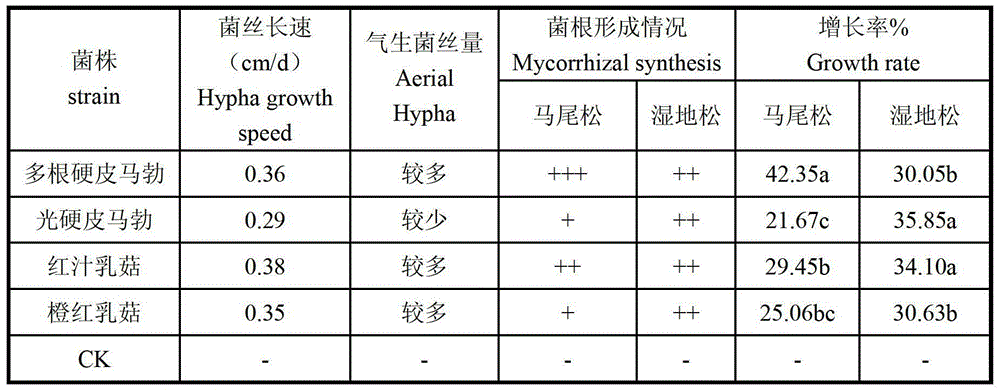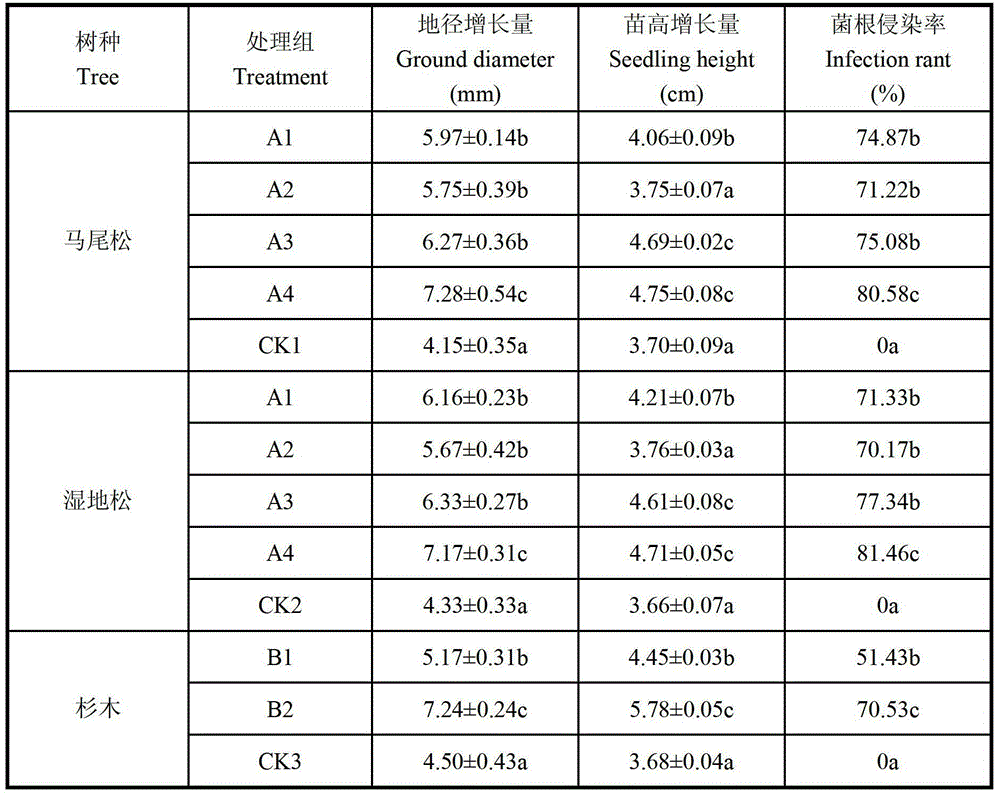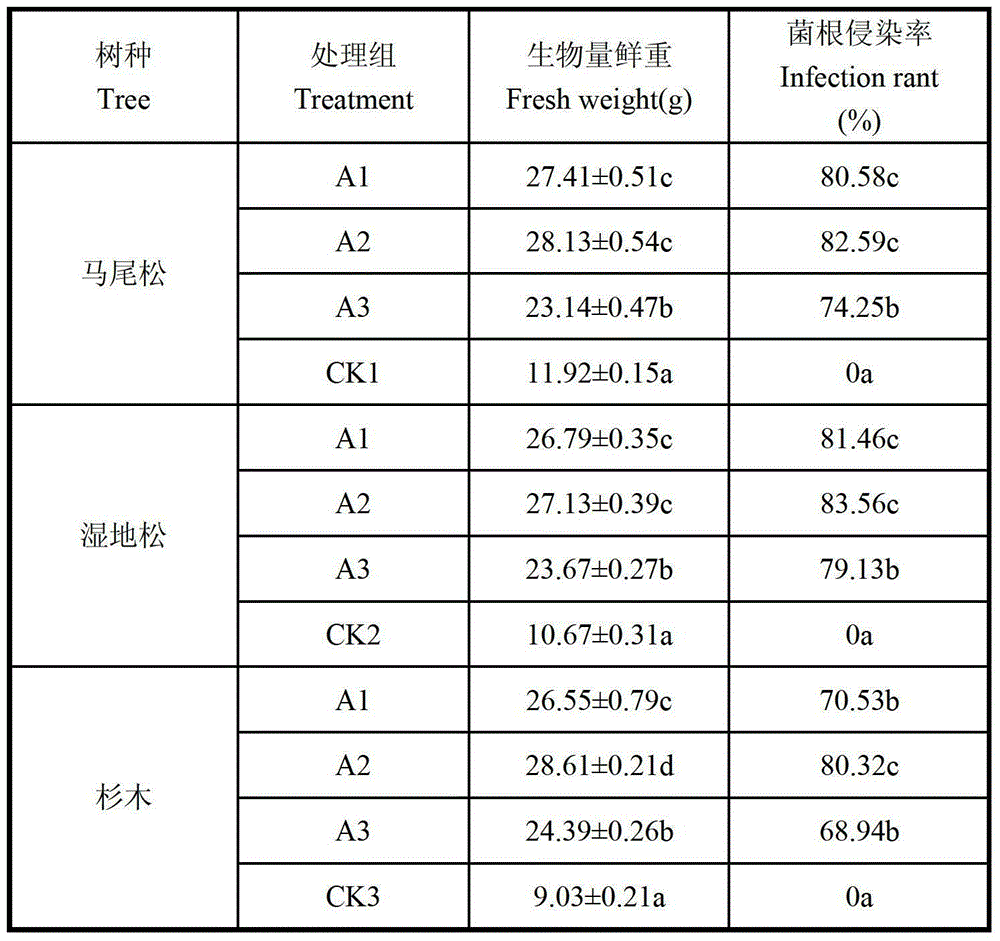Pine or fir artificial forest stress-tolerant growth-promoting composite mycorrhizal fungi inoculant, and preparation and application methods thereof
An application method and technology of ectomycorrhizal fungi, applied in the directions of botanical equipment and methods, applications, biocides, etc., can solve the problems of difficulty in the production of endomycorrhizal fungi, high production costs, application limitations, etc.
- Summary
- Abstract
- Description
- Claims
- Application Information
AI Technical Summary
Problems solved by technology
Method used
Image
Examples
Embodiment 1
[0015] Example 1: Screening of excellent exogenous strains
[0016] Ectomycorrhizal fungus Seleroderma polyrhizum Pers., Scleroderma cepa Pers., Lactarius hatsudake Tanaka, Lactarius akahatsu, Suillus Suillus luteus, Suillus bovines, Cantharellus cibarius Fr., Russula vesca Fr., Amanita phalloides, Scleroderma bovista Fr.10 seed entities were isolated from the comprehensive PDA by tissue Culture, culture conditions: medium is comprehensive PDA (20% potato juice 1000mL, glucose 18g, potassium dihydrogen phosphate 3.0g, magnesium sulfate 1.2g, agar 20g, vitamin B10.01g); culture temperature range is 25°C-28°C ; The pH range is 5-6; The culture medium is prepared for 7 days of first-class plate culture. Observe the growth of each strain.
[0017] After the first-class species were obtained, the back grafting experiment was used to detect the effect on the mycorrhizal synthesis ability of Pinus massoniana and Pine slash seedlings. 4 months after inoculation, from the results of...
Embodiment 2
[0022] Example 2: Excellent combination screening of endogenous and exogenous bacterial strains
[0023] The endophytic mycorrhizal fungi are Glomus mosseae or Glomus intraradices; the ectomycorrhizal fungi are multi-rooted hard puffballs and red milk mushrooms;
[0024] Among them: the endophytic mycorrhizal agent is a mixture containing infectious spores, mycorrhizae and culture substrate obtained by the multiplication and cultivation of the greenhouse pot culture method. Specifically, Glomus mosseae or Glomus intraradices use sorghum as the host plant, sand: vermiculite: soil = 2:1:1 as the culture substrate, and 20 plants / 5L pots as the cultivation density. At the same time, 30% Hoagland's nutrient solution was applied twice a week. After 3-4 months of culture, the spore densities in the culture medium can reach 103 / ml and 97 / ml respectively, and the mycorrhizal infection rates can reach 89.6% and 88.9% respectively.
[0025] The ectomycorrhizal agent is a secondary liquid...
Embodiment 3
[0033] Embodiment 3: Screening of different ratios of each bacterial strain in the composite mycorrhizal agent
[0034] Mix the endogenous and exogenous mycorrhizal agents in different proportions on the ultra-clean workbench, carry out pot experiments on pine fir seedlings, and comprehensively compare the inoculation results of different proportions. The appropriate ratio range of Russula russulae is 1-3:1-2:1; among them, the A2 treatment group has the best effect on the biomass and mycorrhizal infection rate of pine fir seedlings, that is, Glomus moesei:Scleroderma multiroot Pimabo:Red milk mushroom=3:2:1; followed by A1 treatment group. The results are shown in Table 3. (Unless otherwise specified, the ratio of bacterial strains occurring in the present invention all refers to the mass ratio of the culture after cultivation, such as: Glomus mosseae or Glomus intraradices are obtained by the expansion and cultivation of the greenhouse pot culture method Containing a mixtu...
PUM
 Login to View More
Login to View More Abstract
Description
Claims
Application Information
 Login to View More
Login to View More - R&D
- Intellectual Property
- Life Sciences
- Materials
- Tech Scout
- Unparalleled Data Quality
- Higher Quality Content
- 60% Fewer Hallucinations
Browse by: Latest US Patents, China's latest patents, Technical Efficacy Thesaurus, Application Domain, Technology Topic, Popular Technical Reports.
© 2025 PatSnap. All rights reserved.Legal|Privacy policy|Modern Slavery Act Transparency Statement|Sitemap|About US| Contact US: help@patsnap.com



